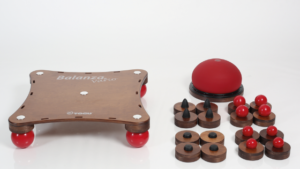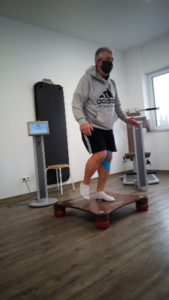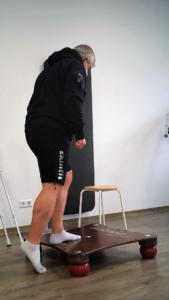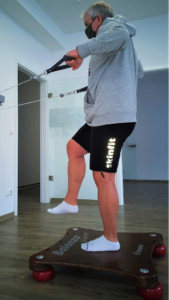Knee stability is important because the knee joint is a heavily loaded joint in the human body. It is essential for many movements in daily life as well as for sports activities. Our blog article is about the important topic of knee stability and rehabilitation after an injury or surgery.
We explain which muscles stabilize the knee and what symptoms may indicate knee instability. In addition, a patient shares his experience with the Balanza Vario, a training device used for knee rehabilitation.
Which muscles stabilize the knee?
There are a number of muscles that stabilize the knee. These include:
- Quadriceps muscles: These are the muscles on the front of the thigh that extend the knee joint and stabilize the joint in full extension.
- Hamstring muscles: These are the muscles on the back of the thigh that flex the knee joint and play an important role in stabilizing the knee.
- Medial and lateral thigh muscles: These muscles are located on the inside and outside of the thigh and help stabilize the knee joint.
- Gastrocnemius muscles: These are the calf muscles that stabilize the knee, especially during activities that require bending the knee.
- Popliteus muscles: This is a small muscle located at the back of the knee that helps stabilize the knee joint.
A combination of all these muscles work together to stabilize and protect the knee joint.
Knee instability – What are the symptoms?
Knee instability can be caused by a variety of factors, including weakness or dysfunction of the stabilizing and inter-joint muscles or due to injury or overuse.
Symptoms of an unstable knee can vary and include a feeling of instability or wobbliness in the knee, knee pain, especially during movements that require bending or rotating the knee. Symptoms of knee osteoarthritis can also include swelling or stiffness of the joint and limited range of motion, which can result in an increased risk of injury, pain and instability, and a reduction in athletic performance.
When these symptoms occur, it is important to consult a physician or physical therapist to determine the cause of the instability and plan appropriate treatment. An accurate diagnosis can help determine the cause of the instability and plan the appropriate treatment to relieve symptoms and restore knee stability.
What causes can lead to knee instability?
Knee instability can be caused by various factors, including injuries such as cruciate ligament tears, meniscus damage or cartilage damage, but also degenerative diseases such as arthritis. Congenital deformities or muscular imbalances can also lead to knee instability. An accurate diagnosis by a physician or physiotherapist is therefore important to identify the cause of the instability and to initiate targeted rehabilitation.
How can knee rehabilitation help?
Targeted knee rehabilitation can help restore or improve knee stability. Specific training can strengthen the affected muscles and tendons to stabilize the knee joint, preventing injury. In addition, rehabilitation can help restore knee joint mobility, reduce pain and build muscle.
Rehabilitation after a knee injury is usually done in close collaboration with a physical therapist. The latter creates an individual training plan that is adapted to the needs and progress of the rehabilitation. Exercises are used that are specifically aimed at strengthening the affected muscles. Strengthening exercises as well as exercises to improve coordination and balance can be used.
Knee rehabilitation with the Balanza Vario from TOGU
The Balanza Vario is a special training device that is specifically used for stabilization training in rehabilitation. It consists of an unstable standing surface with six pick-up points to which various elements such as foam wedges or ball cushions can be attached. These elements increase the instability of the standing surface and require the user to constantly adjust his balance.

Training on the Balanza Vario can specifically improve the stability of the knee joint, as the instability of the standing surface challenges the muscles and tendons used and stimulates them to activate and strengthen. The difficulty of the workout can be adjusted as needed by using different elements or increasing the intensity of the workout.
The Balanza Vario is suitable for use in rehabilitation after a knee injury as well as for preventing injuries and improving general stability and coordination. It is recommended by many physiotherapists and trainers and is also used in physiotherapy practices and in the gym.
The Balanza Vario in practice – A field report
The company TOGU kindly provided me with a Balanza Vario for rehabilitation after my knee surgery. The Balanza Vario is the ideal training device for balance, coordination and strength building in knee rehabilitation. Due to the instability and the resulting dynamic standing surface, I had to continuously counteract and balance the movements with my legs, which is particularly important for stabilizing the knee.

The six pick-up points underneath the Balanza Vario allow a varied combination of the elements supplied, so that an increase in training intensity is easily possible as rehabilitation progresses. The muscles that are important for knee stability are specifically addressed when training with the Balanza Vario.
In the first few hours, the elements were chosen so that I only had to deal with slight instability during my exercises. The longer the rehab lasted, the more the physiotherapists increased the instability and thus increased the demands on me (or on my operated knee).

Das Balanza Vario wurde von den Physiotherapeuten für einbeiniges Stabilisationstraining für das Knie, das Wiedererlernen des Treppensteigens oder Gleichgewichtsübungen in Verbindung mit Core-Training verwendet, um die Muskeln, die für die Stabilität des Knies wichtig sind, gezielt zu trainieren und die Knierehabilitation zu optimieren.

Our TOGU experts advise:
“An important tip for successful knee rehabilitation is to take your time and be patient. A quick recovery is rarely the case and can even lead to an aggravation of the injury. It is important to stick to the rehabilitation plan set up by the doctors and physical therapists and undergo the treatments regularly.
One should also pay attention to one’s own body language and observe the load limits of the knee joint in order to avoid overloading. A balanced diet and adequate sleep are equally important to support the healing process.”
Our expert Markus Kiock, Fitnesstrainer
These products from TOGU might interest you:
Balanza Vario












